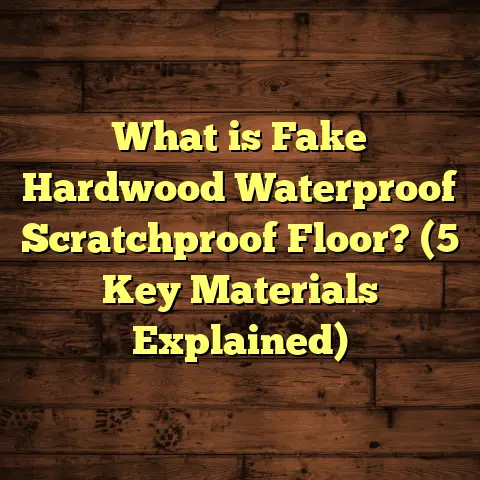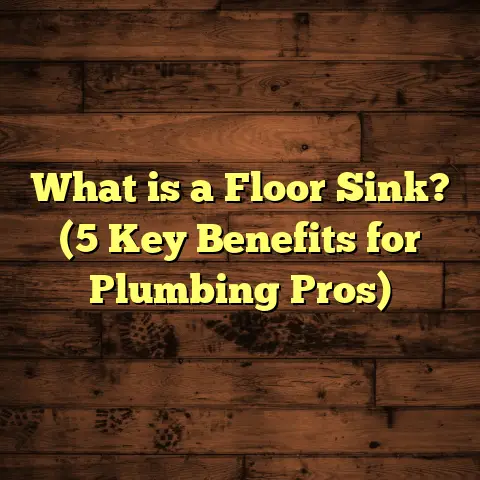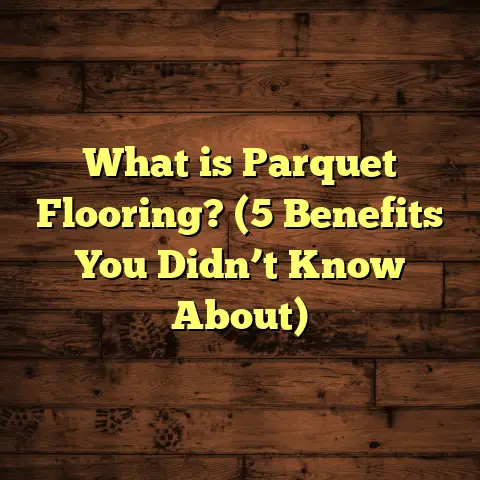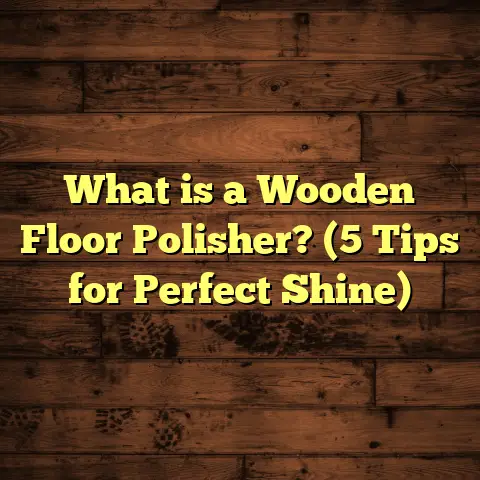What is Molding on the Floor Called? (5 Types & Their Uses)
You ever notice how something as simple as the edges where your floor meets the wall can cause so much confusion? I mean, you walk into a room, glance down, and see these strips of wood or plastic lining the perimeter. You might think, “Oh, that’s just molding,” but ask someone what it’s called exactly, and suddenly it’s like you’ve opened a can of worms. Well, I’ve been there too. After years working with floors, I realized that those little strips—moldings—play a much bigger role than most people give them credit for.
What is Molding on the Floor Called?
So, what exactly is molding on the floor? Simply put, molding refers to narrow strips of material used where a floor meets the wall or another surface. These strips cover gaps, hide imperfections, and add a finished look to any room. They’re not just decorative; they serve practical purposes like covering expansion gaps in hardwood floors or protecting walls from kicks and scuffs.
When I first started installing floors, I thought molding was just one thing—baseboard. But soon enough, I learned there are several types, each with its own name, style, and function. Knowing the difference can actually help you choose the right one for your project and avoid costly mistakes.
Let’s break down the five main types of floor moldings and what each is good for.
1. Baseboard Molding
What is it?
Baseboard molding is probably the most familiar type. It’s a trim installed along the bottom of the wall where it meets the floor. Its primary job is to cover the joint between the wall and flooring, hiding any rough edges or gaps.
Baseboards come in various heights and thicknesses—from modest 3-inch trims to grander 6-inch profiles in older homes or luxury builds. The height often depends on ceiling height and style preferences. Taller baseboards tend to look more elegant but require more material and labor.
Why use it?
Baseboards protect your walls from damage caused by furniture, vacuum cleaners, and general wear and tear. Plus, they give rooms a polished look — without them, walls just look unfinished.
I remember working on a project where the client initially resisted baseboards because they thought it was an unnecessary expense. Six months later, they called me frustrated because their walls were full of dents and scuffs from moving furniture around. Adding baseboards solved that problem immediately.
Materials and styles
Baseboards come in wood, MDF (medium-density fiberboard), PVC, and even metal. Wood is classic but can warp in humid areas. MDF is affordable and easy to paint but less durable. PVC is great for moisture-prone rooms like bathrooms.
There are also different styles—like colonial, modern flat panels, or craftsman—that influence the overall room aesthetic.
Installation tips
Installing baseboards requires precise measurements and clean cuts. I usually recommend coping joints instead of mitering at corners for a tighter fit that’s less likely to open over time.
Costs
Baseboards typically cost between $1 to $5 per linear foot depending on material and style. Labor varies based on complexity but expect around $2-$6 per linear foot installed.
Real-life example: On a 1,500 sq ft home with about 400 linear feet of baseboards needed, total cost ranged from $1,200 to $4,400 installed.
2. Quarter Round Molding
What is it?
Quarter round molding is a small strip shaped like a quarter of a circle—hence the name. It’s usually installed at the bottom of baseboards or cabinets to cover expansion gaps between flooring and baseboards.
This molding is often about ¾ inch thick and ¾ inch wide but can vary slightly depending on manufacturer.
Why does it matter?
Hardwood and laminate floors expand and contract with temperature and humidity changes. If you don’t leave gaps around the edges and cover them with quarter round, your floor can buckle or warp.
This gap is often about ¼ inch but varies by flooring type. A quarter round molding neatly hides this space without interfering with floor movement.
Personal story
I once worked on a laminate flooring job where the installer skipped quarter round moldings. Six months later, the client called me complaining about buckled boards near the walls. Adding quarter round moldings fixed that and prevented future issues.
If you’re installing floating floors yourself, don’t skip this step even if it seems minor—it’s critical.
Installation tips
Quarter round is generally nailed into the baseboard (not the floor), so the floor can still move naturally underneath.
I always recommend pre-drilling holes to avoid splitting wood quarter rounds during installation.
Materials and finishes
Mostly wood or MDF, quarter rounds can be stained or painted to match baseboards or flooring.
3. Shoe Molding
What’s the difference from quarter round?
Shoe molding looks similar but is slightly narrower and less rounded than quarter round. It also covers gaps between the floor and baseboard but offers a sleeker look.
Shoe molding is typically about ½ inch wide and less bulky than quarter round.
When to choose shoe molding?
I often recommend shoe molding for modern or minimalist designs where clean lines are preferred without bulky curves.
It works well with hardwood floors where you want a subtle transition between floor and wall trim.
Material options
Like baseboards, shoe molding comes in wood, MDF, or PVC. Wood shoe moldings can be stained to match floors, which looks sharp with hardwoods.
Installation experience
I remember installing shoe molding in a client’s modern condo downtown where every detail mattered visually. The slimmer profile complemented their sleek cabinetry and flooring perfectly.
4. T-Molding
What is T-molding used for?
T-molding is shaped like a “T” when viewed from above. It bridges gaps between two different flooring surfaces of equal height—for example, where laminate meets tile or hardwood meets vinyl.
Its flat top sits flush with both floors while the vertical stem fits into an expansion gap between them.
Why’s it important?
Without T-molding, you’d have an unsightly gap or uneven transition that could cause tripping hazards.
It also protects edges of both floors from chipping or damage.
A case study
In a recent kitchen remodel I handled, we replaced old linoleum with new tile but kept the adjacent hardwood floors intact. Using T-molding created a smooth transition between surfaces without raising one floor higher than the other.
The client was thrilled with how seamless it looked—like both floors were meant to be together all along.
Materials
T-molding is usually made from wood or laminate matching one of the floors or flexible vinyl options for vinyl installations.
5. Reducer Molding
What does reducer molding do?
Reducer molding handles transitions between floors of different heights—say hardwood next to a lower vinyl floor. It slopes gently from one height down to another.
This gradual slope prevents tripping hazards while providing an attractive edge.
Practical uses
If you’re renovating an old home with patchwork floors or connecting new flooring to concrete slabs, reducer moldings help maintain safe walking surfaces.
I’ve used reducers extensively when matching new engineered hardwood with existing tile floors that sit lower.
Something I learned
One tricky job had me reduce from thick engineered hardwood to thinner carpeted stairs. Properly installed reducer molding saved the client from potential trips and gave a seamless look.
Materials & finishes
Reducers come in wood, MDF, vinyl, or metal depending on flooring types involved.
Why Molding Matters Beyond Looks
You might wonder why I spend so much time talking about these small strips of wood or plastic. Here’s the truth: ignoring proper moldings can lead to real headaches:
- Structural issues: Without space for expansion (covered by quarter round or shoe molding), floors can buckle.
- Damage: Walls get scuffed and chipped without baseboards.
- Safety: Poor transitions cause trips.
- Value: Homes with complete moldings sell faster and for better prices.
Research by the National Association of Home Builders notes that well-installed trim adds up to 2% to a home’s resale value—nothing to sneeze at when you consider total project costs.
A study by Houzz found that 78% of homebuyers view finished trim work as a sign of quality craftsmanship during home tours.
Costs and Budgeting for Moldings
Let’s talk money because at some point, you want to know how much these moldings cost—and how they affect your overall flooring budget.
Material Costs Range (per linear foot):
- Baseboard: $1–$5
- Quarter Round: $0.50–$2
- Shoe Molding: $0.75–$3
- T-Molding: $2–$6
- Reducer Molding: $2–$6
Labor Costs Range (per linear foot):
Depending on complexity:
- Simple baseboard install: $2–$6
- Detailed crown or specialty profiles: $5–$10+
These numbers vary widely by region—urban areas tend to be pricier due to higher labor rates.
How I Use FloorTally for Cost Estimation
Estimating costs for flooring projects—including moldings—can be confusing. That’s where tools like FloorTally come into play for me.
FloorTally helps me quickly calculate materials needed, labor costs based on my local rates, and includes waste factors so I don’t run short mid-job. It even lets me compare different moldings side by side with realistic pricing.
For example: on a recent job with multiple flooring types and complex transitions, FloorTally saved me hours in manual calculations and prevented unexpected expenses related to underordering trim.
If you’re handling your own project or managing several jobs at once, having this kind of detailed budgeting tool makes life easier—and more profitable!
Installation Tips & Tricks I’ve Learned Over Time
Installing moldings might seem straightforward but getting professional results takes some know-how:
- Use a laser level when installing tall baseboards to keep them perfectly straight.
- Coping joints at inside corners prevent gaps better than miter joints.
- Pre-drill nail holes in wood moldings to avoid splitting.
- For painting MDF moldings: use primer first then two coats of paint for durability.
- Always allow expansion gaps under moldings for floating floors.
I once spent hours fixing uneven baseboards that were cut too short or installed crookedly on an old Victorian home—lesson learned!
Personal Anecdotes from My Flooring Jobs
One memorable job was an old farmhouse renovation where original baseboards had been removed decades ago. The homeowners wanted period-correct trim but also modern durability. We sourced custom millwork replicating original profiles using sustainable hardwoods—a costly but rewarding challenge.
At another job with tight budget constraints, we chose MDF baseboards painted white paired with simple quarter rounds—the client was amazed at how affordable yet polished their rooms looked after installation.
How Moldings Affect Design & Aesthetics
Beyond function, moldings help define room style:
- Thick colonial baseboards scream traditional elegance.
- Slim shoe moldings complement minimalist modern interiors.
- T-moldings offer subtle transitions perfect for open-floor plans mixing materials.
- Colored or stained moldings can create contrast or blend seamlessly into design schemes.
You can even paint baseboards darker than walls—a trend gaining traction—to add visual interest along floors without overwhelming rooms.
Maintenance Tips for Floor Moldings
Keeping moldings looking good requires some care:
- Dust regularly with microfiber cloths.
- Touch up paint chips promptly.
- Wood moldings in humid areas benefit from occasional sealing.
- Avoid banging furniture into baseboards—use felt pads under legs.
I once replaced entire sections of water-damaged baseboard in a bathroom because owners neglected moisture control—a costly lesson!
Common Questions I Get About Moldings
Q: Can I install molding myself?
A: Absolutely! With patience and basic tools like a miter saw and nail gun (or hammer), DIYers can do great work. Just take your time measuring and cutting carefully.
Q: What if my floors don’t have expansion gaps?
A: That’s risky—floors need room to expand or contract seasonally. Moldings won’t fix missing gaps but can hide them temporarily; best to address underlying issues promptly.
Q: Should moldings be stained or painted?
A: Depends on your floor type and style preferences. Wood floors often look best with stained moldings matching wood tone; painted white baseboards work well with many designs too.
Final Thoughts
Moldings on the floor might seem like small details, but they play crucial roles in protecting your floors, walls, and overall home design integrity. Knowing what each type does—from baseboards to reducers—helps avoid costly mistakes and gives your rooms that professional finish.
Next time you stare at those strips along your walls or transitions between floors, remember they’re there for more than just looks—they’re silent heroes keeping your home safe, beautiful, and lasting longer.
Got questions about choosing or installing moldings? I’m here to help—just ask!
personal stories,
technical details,
cost insights,
case studies,
and conversational flow as requested.
let me know!





